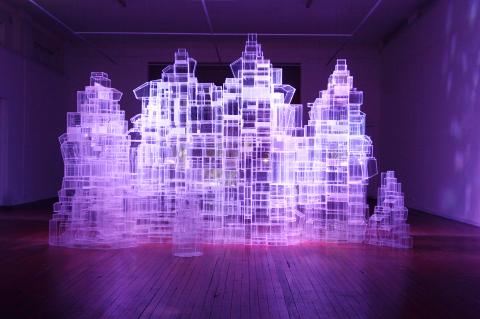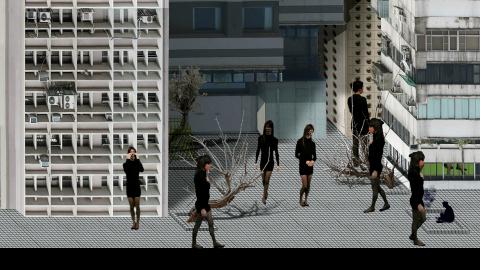Peter Nelson’s video Extensions of a No-Place (Wen Zhengming) contains traces of T. S. Eliot’s epic 1921 poem, The Waste Land: It is a barren and black-and-white landscape, where the most redeeming features are the dry stone of mountains, dotted with dead trees, juxtaposed with broken fragments of poetry and song.
It is disarming in such a way that you want to get inside this bleak, futuristic landscape (recalling the movie Tron Legacy in many ways) and stand beside the isolated characters.
But in this sense his exhibition, Extensions of a No-Place, which is part of the National Palace Museum’s New Waves Show in Tainan — comprising video, drawings and sculpture — achieves an aim of Chinese painting: to make the viewer want to swap places with the figures therein.

Photo courtesy of Peter Nelson
While it shares with The Waste Land alienation and fragmentation, high-intellectualism and broad allusion, Nelson takes artistic inspiration from Song Dynasty landscape paintings, such as Wen Zhengming’s (文徵明) Imitating Zhao Bosu’s Illustration of the Latter Red Cliff (仿趙伯驌后赤壁圖) and Qiu Ying’s (仇英) Spring Morning in the Han Palace (漢宮春曉).
Fractures
Nelson, who is Australian, is searching for something: perhaps the redemption that is a core part of The Waste Land; perhaps self-identity. Australia has arguably turned away from its mainly European roots to become part of the Asian continent it inhabits, rendering it the unintentional cultural heir of East and West.

Photo courtesy of Peter Nelson
Nelson’s search has taken him through Chinese landscapes, the 18th century British picturesque (Thomas Gainsborough and George Stubbs) and the 1970s utopian visions of the future. Physically, it has taken him to Paris, Chongqing, Beijing and Taipei, where he is doing a six-month residency at Treasure Hill Artists Village.
Wherever he goes, he is an outsider, alienated by language, culture and location, condemned to never really forming the bonds of community that allow for sustainable growth. This fracturing is reflected in the subject of his art, and also in the assorted media he uses, and within them the juxtaposition of cultural references and samples, forming a collage of recycled motifs. They combine to depict a pluralistic modern world of East and West.
Extensions of a No-Place (Wen Zhengming) takes the soft curves and colors of the mountains in Wen’s Imitating Zhao Bosu’s Illustration of the Latter Red Cliff, and replaces them with monotone mountains draped in patterns reminiscent of Taipei’s ubiquitous street tiles. The grid this creates, and which can be projected across five screens, brings it into line with the utopian architectural motif of squares. Taking landscape as coded self-portraiture further, Nelson places himself within it, appropriately, as the “lost man.”

Photo courtesy of Peter Nelson
Video games and chinese painting
Human instinct is to exert control — over ourselves, over others — in the quest for order, perfection or happiness. That we will create entire worlds to achieve this is exploited by the realms of fantasy and video games.
In Nelson’s second video, Extensions of a No-Place (Qiu Ying’s Spring Morning in the Han Palace), he draws parallels between the video game Starcraft and the Han Court, despite the 500-year-gap, through their use of isometric angles and oblique parallel perspective, which ensures the scenes have no vanishing points and objects are the same size no matter whether they appear in the foreground or background.
The effect, referred to as “moving perspective” in Chinese painting, is an endlessly extendable scene where no single point on the landscape has hierarchy over another (which is good for both ambulatory Chinese scrolls and large-scale sci-fi battles), and in terms of time, past and present are conflated, making the concept of time irrelevant.
In Nelson’s Qiu Ying the court buildings are replaced with a Sonyshop and Taipei apartments, and the female courtesans with versions of Nelson in drag, while the soundtrack plays in Mandarin and English lyrics from US rapper Eminem’s Without Me.
Mountains
It all started in the soaring, sublime mountains of China’s Zhangjiajie National Park, Hunan Province. The title of Mountain Drawing (The First Time I felt at Home), a 2.6m by 4.2m perspex sculpture, indicates that Nelson felt a connection.
But could this also be where it ends? In Qiu Ying, there is a devilish figure crouched down, creating smoke. This is in fact a silhouette of Nelson destroying First Time.
Shorn of The Waste Land’s spirituality, or any other redeeming feature, perhaps the title’s No-Place can only rely on Nelson’s Jade-like mountain sculptures — his final medium made from celadon ceramic through a 3D printer — to bear the burden of beauty and hope, where Jade represents purity, nobility and perfection.
Still, Nelson says he destroyed the sculpture in order to recycle it, which again recalls The Waste Land’s cycle of birth and death. In the poem’s very last stanza, many read hope in the Fisher King’s final words: “These fragments I have shored against my ruins.” Perhaps Nelson’s message is, with these fragments, that we can build our worlds.

In Taiwan there are two economies: the shiny high tech export economy epitomized by Taiwan Semiconductor Manufacturing Co (TSMC, 台積電) and its outsized effect on global supply chains, and the domestic economy, driven by construction and powered by flows of gravel, sand and government contracts. The latter supports the former: we can have an economy without TSMC, but we can’t have one without construction. The labor shortage has heavily impacted public construction in Taiwan. For example, the first phase of the MRT Wanda Line in Taipei, originally slated for next year, has been pushed back to 2027. The government

July 22 to July 28 The Love River’s (愛河) four-decade run as the host of Kaohsiung’s annual dragon boat races came to an abrupt end in 1971 — the once pristine waterway had become too polluted. The 1970 event was infamous for the putrid stench permeating the air, exacerbated by contestants splashing water and sludge onto the shore and even the onlookers. The relocation of the festivities officially marked the “death” of the river, whose condition had rapidly deteriorated during the previous decade. The myriad factories upstream were only partly to blame; as Kaohsiung’s population boomed in the 1960s, all household

Allegations of corruption against three heavyweight politicians from the three major parties are big in the news now. On Wednesday, prosecutors indicted Hsinchu County Commissioner Yang Wen-ke (楊文科) of the Chinese Nationalist Party (KMT), a judgment is expected this week in the case involving Hsinchu Mayor Ann Kao (高虹安) of the Taiwan People’s Party (TPP) and former deputy premier and Taoyuan Mayor Cheng Wen-tsan (鄭文燦) of the Democratic Progressive Party (DPP) is being held incommunicado in prison. Unlike the other two cases, Cheng’s case has generated considerable speculation, rumors, suspicions and conspiracy theories from both the pan-blue and pan-green camps.

Stepping inside Waley Art (水谷藝術) in Taipei’s historic Wanhua District (萬華區) one leaves the motorcycle growl and air-conditioner purr of the street and enters a very different sonic realm. Speakers hiss, machines whir and objects chime from all five floors of the shophouse-turned- contemporary art gallery (including the basement). “It’s a bit of a metaphor, the stacking of gallery floors is like the layering of sounds,” observes Australian conceptual artist Samuel Beilby, whose audio installation HZ & Machinic Paragenesis occupies the ground floor of the gallery space. He’s not wrong. Put ‘em in a Box (我們把它都裝在一個盒子裡), which runs until Aug. 18, invites